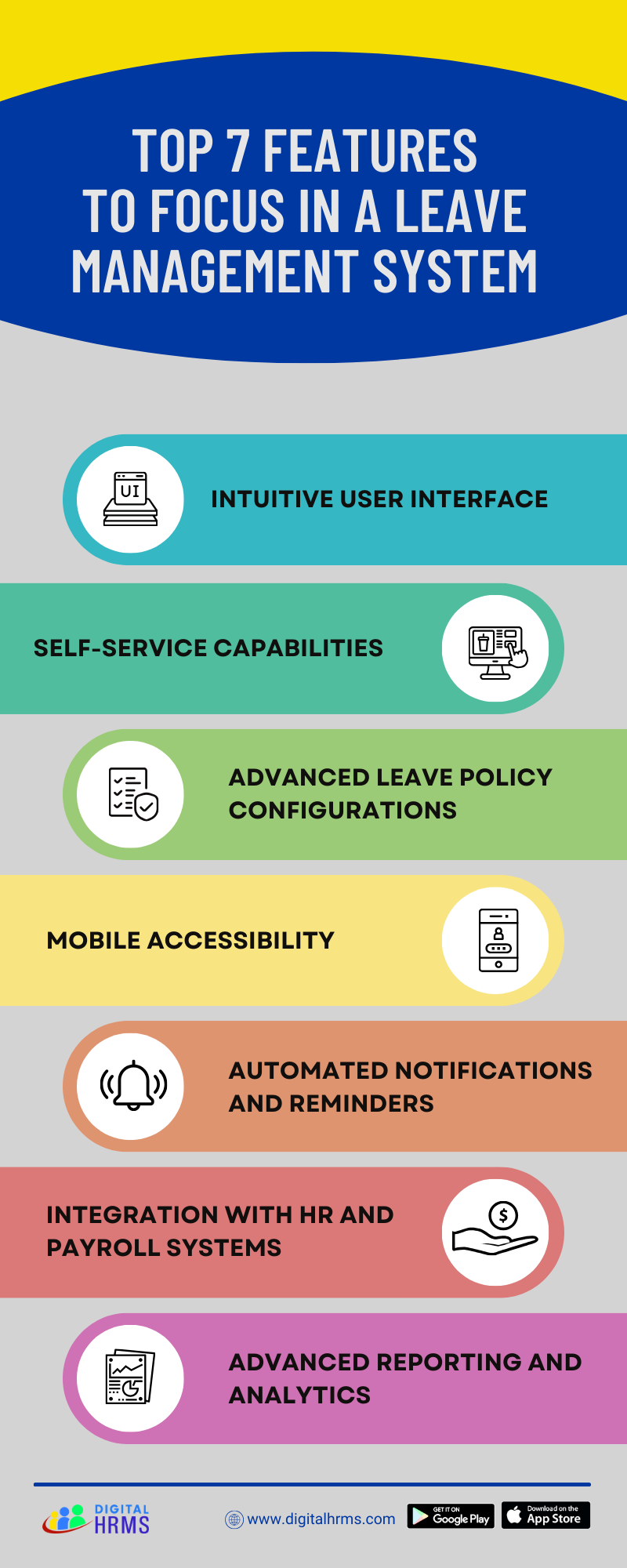7 Top Features to Focus on In a Leave Management System In 2023 That Will Elevate HR Productivity to New Level

Introduction:
Leave management systems have become an integral part of modern workplaces, streamlining and automating the process of requesting, approving, and tracking employee leaves. As we delve deeper into the year 2023, it's crucial for organizations to stay up to date with the latest features in leave management systems. This blog highlights the top features to focus on in a leave management system to enhance efficiency, transparency, and employee satisfaction.
Top 7 Features to Focus in a Leave Management System

1) Intuitive User Interface:
In 2023, user experience plays a vital role in any software solution, and leave management systems are no exception. An intuitive and user-friendly interface ensures that employees can easily navigate through the system, making leave requests and accessing relevant information effortlessly. Features like a clean dashboard, visual calendars, and easy-to-understand icons contribute to an enhanced user experience.
2) Self-Service Capabilities:
Empowering employees to manage their own leave requests saves time for both employees and HR personnel. A robust leave management system should offer self-service capabilities, allowing employees to submit leave requests, view their leave balances, check the status of requests, and even make modifications if necessary. Self-service features enable greater autonomy and convenience for employees, reducing administrative overhead.
3) Advanced Leave Policy Configurations:
Each organization has unique leave policies and rules that need to be implemented within the system. In 2023, leave management systems should offer flexible configurations to accommodate diverse policies such as accrual methods, leave types, carry-over limits, and automatic approval rules. Customization options of attendance management tools enable organizations to align the system with their specific requirements and ensure accurate leave calculations.
4) Mobile Accessibility:
In an era where remote work and flexible schedules are prevalent, mobile accessibility has become crucial for leave management systems. Mobile apps or responsive web interfaces enable employees to manage their leave requests on the go, from any location and device. Mobile accessibility enhances convenience, promotes faster approvals, and improves overall communication between employees and HR personnel.
5) Automated Notifications and Reminders:
Effective communication is essential when it comes to managing leave requests. A leave management system should include automated notifications and reminders for various stakeholders, including employees, managers, and HR personnel. These notifications can be used to inform employees about the status of their leave requests, remind managers about pending approvals, or notify HR about upcoming leave periods through an attendance management tool. Timely and automated communication helps avoid confusion and ensures everyone stays informed.
6) Integration with HR and Payroll Systems:
Seamless integration between the leave management system and other HR and payroll systems enhances data accuracy and reduces manual data entry. In 2023, leave management systems should provide integration capabilities with popular HR and payroll software, allowing for the automatic transfer of leave data, such as approved leaves, balances, and time-off details. Integration of attendance management tools ensures consistency across systems and minimizes errors.
7) Advanced Reporting and Analytics:
Leave data can provide valuable insights into employee absence patterns, productivity trends, and resource planning. A modern leave management system or an attendance management tool should offer robust reporting and analytics features that enable HR personnel to generate comprehensive reports, visualize leave trends, and identify patterns. These insights can assist in decision-making, identifying bottlenecks, and optimizing leave policies to enhance workforce management.
Conclusion:
In 2023, organizations must invest in leave management systems that align with the evolving needs of modern workplaces. By focusing on intuitive user interfaces, self-service capabilities, advanced leave policy configurations, mobile accessibility, automated notifications, integration capabilities, and advanced reporting and analytics, businesses can streamline their leave management processes, reduce administrative burdens, and foster a positive employee experience. Implementing these top features will undoubtedly contribute to a more efficient, transparent, and well-organized leave management system in the years to come.
In 2023, an automated leave management system has the potential to significantly elevate HR productivity by streamlining processes, reducing administrative burdens, and enhancing overall efficiency. By leveraging the power of automation, self-service features, streamlined workflows, accurate calculations, real-time reporting, integration, and improved communication, an automated leave management system in 2023 can empower HR personnel to work more efficiently, reduce manual tasks, and dedicate their time and expertise to strategic HR initiatives that add value to the organization.
Keeping up with the latest requirements and addressing the challenges faced by enterprises, the Digital HRMS's Leave and Attendance module has added several new features and gives employees access to crucial warnings so they can respond. Visit our website at www.digitalhrms.com or send us an email at marketing@digitalhrms.com and one of our representatives will get in touch with you if you. For the next 90 days, get free full access to Digital HRMS with all its latest features!
